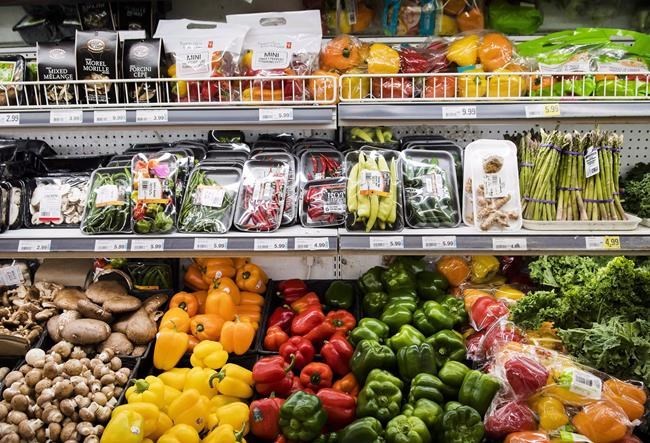Canada's grocery sector needs more competition to help keep food prices down, give shoppers more choice and encourage new entrants, the country's competition watchdog says.
In a highly anticipated study released Tuesday, the Competition Bureau said concentration in the grocery industry has increased in recent years and the largest grocers have increased the amount they make on food sales.
Most 91ԭ��s buy groceries in stores owned by a handful of grocery giants, with Canada’s three largest grocers — Loblaws, Sobeys, and Metro — collectively reporting more than $100 billion in sales and $3.6 billion in profits last year, the study found.
Food gross margins have generally increased over the last five years by a "modest yet meaningful" amount of one or two percentage points, the Competition Bureau said.
"This longer-term trend predates the supply chain disruptions faced during the pandemic and the current inflationary period," it said.
That's roughly equivalent to $1 to $2 on each $100 that 91ԭ��s spend on groceries, the study found.
The regulator said this signals the need for more competition in Canada’s grocery industry.
"Canada needs solutions to help bring grocery prices in check," the study said. "More competition is a key part of the answer."
The competition watchdog proposed four recommendations to improve competition and lower prices, including an innovation strategy to support new grocery businesses and expand consumer choice.
It also recommends governments encourage the growth of independent grocers and the entry of international grocers into the 91ԭ�� market, standardize unit pricing to help 91ԭ��s easily compare prices, and curb real estate practices in the industry that limit competition, such as putting covenants on sold land that prevents any new grocer from operating there.
Gary Sands, senior vice-president of public policy with the 91ԭ�� Federation of Independent Grocers, said the study recognizes that more needs to be done to support independent grocers in Canada.
"They've drawn attention to some of the challenges that are faced by independent grocers," he said. "There are a lot of barriers to entry that make it hard to compete with the chains and this will hopefully lead to some changes."
Karl Littler, senior vice-president of public affairs with the Retail Council of Canada, said the study proves that major grocery chains have not made an excessive profit on food.
"We see this as another nail in the coffin of the greedflation hysteria," he said, referring to allegations that higher prices during the pandemic have been due to grocery chains engaged in price gouging and so-called greedflation — raising prices by more than the rate of inflation.
However, the Bureau said its inability to compel information as part of the study limited its access to some details and highlighted the need for more formal information-gathering powers.
It said it also needs to approach its work in the grocery industry with "heightened vigilance and scrutiny" to ensure 91ԭ��s benefit from greater choice and more affordable groceries.
"We need to thoroughly and quickly investigate allegations of wrongdoing, and we need the power to act when issues arise," the study said.
In a survey of consumer attitudes and opinions about the grocery sector, some 91ԭ��s said the country's laws don't go far enough to stop deals that are bad for competition, while others felt the Competition Bureau has just not done a good enough job enforcing those laws, the study said.
When the Competition Act was introduced in 1986, there were at least eight large grocery chains across Canada, the study said. Each was owned by a different company.
Today there are five large chains that operate in Canada: Loblaw, Sobeys, Metro, Costco and Walmart.
The competition watchdog committed to taking steps to better promote competition in the 91ԭ�� grocery industry, including providing a pro-competitive perspective to support the implementation of Canada’s grocery code of conduct.
It also committed to revisiting the findings of its study in three years to assess the progress on recommendations it has made to government.
The concentrated nature of Canada's grocery's sector has come under intense scrutiny in recent years.
The big three grocery chains have been embroiled in an alleged bread price-fixing scheme, which observers say has triggered distrust of the grocery industry.
The large grocers have also been accused of wage fixing after simultaneously scrapping pandemic bonuses for front-line workers.
It's behaviour the House of Commons industry committee likened to "cartel-like practices" in a June 2021 report.
Yet Canada's grocers have argued that consolidation increases efficiencies and provides consumers with more value, even as their profits have climbed.
The House of Commons agriculture committee has floated the idea of a windfall tax on those profits to "disincentivize excess hikes in their profit margins for these items."
Meanwhile, a grocery industry committee is continuing to hammer out a new code of conduct that would help level the playing field between large grocers, independents and suppliers.
Food prices have recorded a massive spike in Canada since November 2021 — the last month for which grocery inflation was under five per cent.
Since then, grocery prices have consistently risen by close to double digits, peaking at an 11.4 per cent year-over-year price hike last September and again in November before easing somewhat in recent months.
Statistics Canada said Tuesday grocery prices rose nine per cent year over year in May.
This report by The 91ԭ�� Press was first published June 27, 2023.
Companies in this story: (TSX:L, TSX:EMP.A, TSX:MRU)
Brett Bundale, The 91ԭ�� Press




